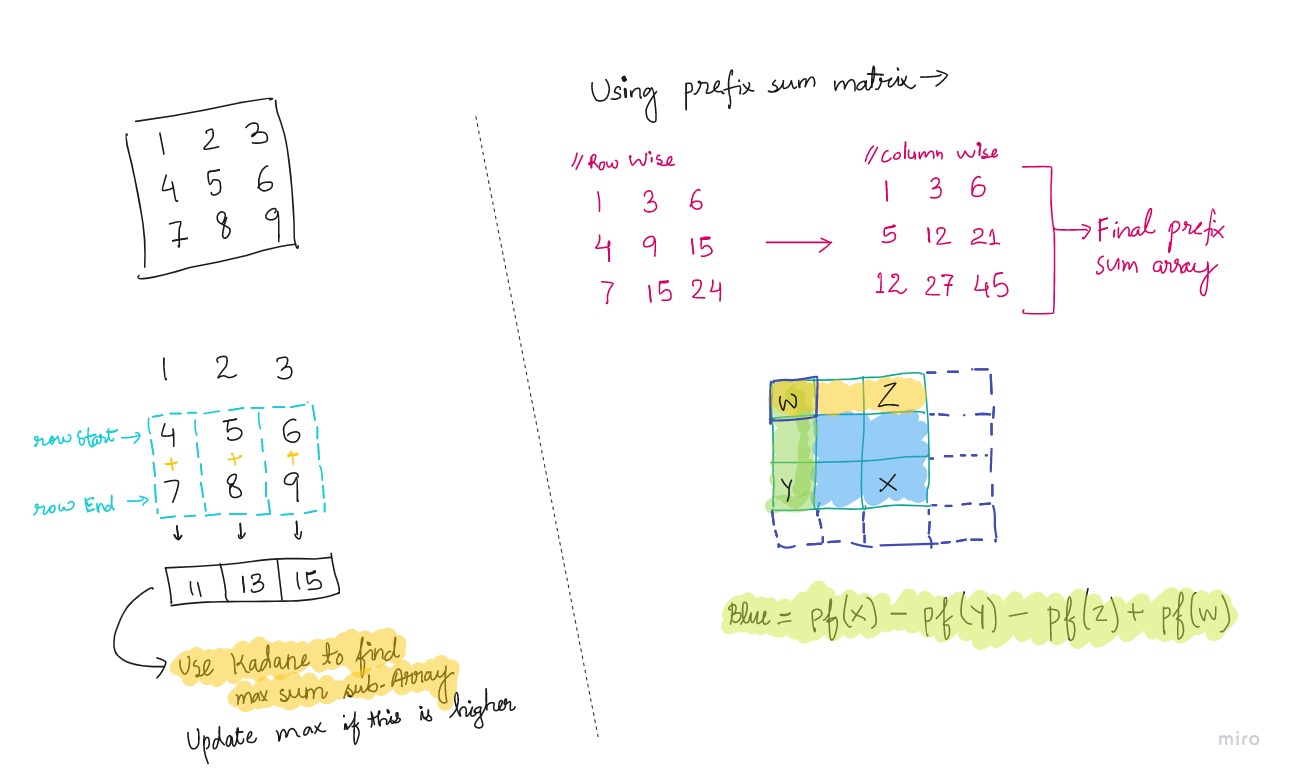Problem Description
Given a 2D matrix, find the maximum possible sum of sub-matrices in that matrix.
Solution
The brute force approach is to get all sub-matrices, calculate the sum and update the max-sum as we go on. Obviously the time complexity will be very high: O(N^2M^2). We can optimize it to O(NM) which is the best possible time complexity possible for any matrix.
- First create a prefix sum matrix for the given matrix. To do this, first take the row-wise sum. Then do the same thing column wise.
1
2
3
4
5
6
7
8
9
10
11
12
13
14
15
16
17
18
19
20
21
22
23
24
25
26
27
int[][] pf = new int[n][m];
//Create prefix array
//Row wise
for(int i=0; i<n; i++){
for(int j=0; j<m; j++){
if(j == 0){
pf[i][j] = matrix[i][j];
}else{
pf[i][j] = pf[i][j-1] + matrix[i][j];
}
}
}
//column wise
for(int j=0; j<m; j++){
for(int i=0; i<n; i++){
if(i == 0){
pf[i][j] = pf[i][j];
}else{
pf[i][j] = pf[i-1][j] + pf[i][j];
}
}
}
- Create a method to get the sum of any given sub-matrix using the above created prefix sum matrix.
1
2
3
4
5
6
7
8
9
10
11
12
13
14
15
public int getSumOfSubMatrix(int[][] pf, int topX, int topY, int bottomX, int bottomY){
int sum = 0;
if(topX==0 && topY == 0){
sum = pf[bottomX][bottomY];
}else if(topY==0){
sum = pf[bottomX][bottomY] - pf[topX-1][bottomY];
}else if(topX == 0){
sum = pf[bottomX][bottomY] - pf[bottomX][topY-1];
}else{
sum = pf[bottomX][bottomY] - pf[bottomX][topY-1] - pf[topX-1][bottomY] + pf[topX-1][topY-1];
}
return sum;
}
Now, the important part: We will fix the rows first using two loops. Something like:

1
2
3
4
5
6
7
for(int i=0; i<n; i++){ //start row
for(int j=i; j<n; j++){ //end row
//logic to get sum of the sub-matrix between startRow and EndRow.
//Then use Kadane's algorithm to get the maximum possible column wise.
//Update the max sum if this is higher
}
}
Complete Code:
1
2
3
4
5
6
7
8
9
10
11
12
13
14
15
16
17
18
19
20
21
22
23
24
25
26
27
28
29
30
31
32
33
34
35
36
37
38
39
40
41
42
43
44
45
46
47
48
49
50
51
52
53
54
55
56
57
58
59
60
61
62
63
64
65
66
67
68
69
70
71
72
73
74
75
76
77
78
79
80
81
82
83
84
85
86
87
88
89
90
91
92
93
94
95
96
97
98
99
100
101
package com.gauk;
import java.util.*;
import java.util.*;
class Program {
public int maximumSumSubmatrix(int[][] matrix) {
int n = matrix.length;
int m = matrix[0].length;
int[][] pf = new int[n][m];
//Create prefix array
//Row wise
for(int i=0; i<n; i++){
for(int j=0; j<m; j++){
if(j == 0){
pf[i][j] = matrix[i][j];
}else{
pf[i][j] = pf[i][j-1] + matrix[i][j];
}
}
}
//column wise
for(int j=0; j<m; j++){
for(int i=0; i<n; i++){
if(i == 0){
pf[i][j] = pf[i][j];
}else{
pf[i][j] = pf[i-1][j] + pf[i][j];
}
}
}
int maxSum = Integer.MIN_VALUE;
for(int i=0; i<n; i++){ //start row
for(int j=i; j<n; j++){ //end row
int[] verticalSumArray = getColumnSumBetweenRows(pf, i, j);
int sumByKardane = kadanesAlgorithm(verticalSumArray);
maxSum = Math.max(sumByKardane, maxSum);
}
}
return maxSum;
}
public int getSumOfSubMatrix(int[][] pf, int topX, int topY, int bottomX, int bottomY){
int sum = 0;
if(topX==0 && topY == 0){
sum = pf[bottomX][bottomY];
}else if(topY==0){
sum = pf[bottomX][bottomY] - pf[topX-1][bottomY];
}else if(topX == 0){
sum = pf[bottomX][bottomY] - pf[bottomX][topY-1];
}else{
sum = pf[bottomX][bottomY] - pf[bottomX][topY-1] - pf[topX-1][bottomY] + pf[topX-1][topY-1];
}
return sum;
}
public int[] getColumnSumBetweenRows(int[][] pf, int startRow, int endRow){
int columns = pf[0].length;
int[] vsum = new int[columns];
for(int i=0; i<columns; i++){
vsum[i] = getSumOfSubMatrix(pf, startRow, i, endRow, i);
}
return vsum;
}
public static int kadanesAlgorithm(int[] array) {
int maxSum = Integer.MIN_VALUE;
int maxSumTillHere = 0;
for(int i=0; i<array.length; i++){
maxSumTillHere = Math.max(maxSumTillHere + array[i], array[i]); //Either the sum will increase if we include the next number OR the next number has a larger value
maxSum = Math.max(maxSum, maxSumTillHere);
}
return maxSum;
}
}
